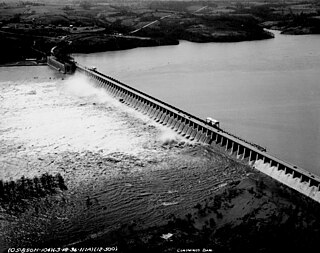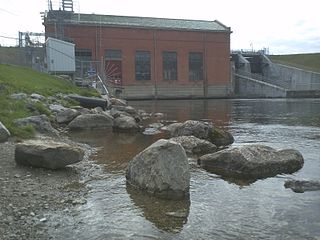
The Limerick Generating Station is a nuclear power plant in Pennsylvania located next to the Schuylkill River in Limerick Township, Montgomery County, northwest of Philadelphia. The facility has two General Electric boiling water reactor (BWR) units, cooled by natural draft cooling towers. According to its owner, Constellation Energy, the two units are capable of producing 2,317 megawatts of power, which combined would provide electricity to around 2 million households. Constellation owns and operates this facility following their separation from Exelon Corporation in 2022. With the exception of refueling outages, Limerick Generating Station continuously operates at 100% power. The plant is connected to the grid, and transmits power, via multiple 500kv transmission lines.
The Public Service Enterprise Group, Inc. (PSEG) is a publicly traded diversified energy company headquartered in Newark, New Jersey, US, established in 1985 with a legacy dating back to 1903.

Southern California Edison (SCE), the largest subsidiary of Edison International, is the primary electric utility company for much of Southern California. It provides 15 million people with electricity across a service territory of approximately 50,000 square miles.

The Peach Bottom Atomic Power Station is an American nuclear power plant that is located 50 miles (80 km) southeast of Harrisburg in Peach Bottom Township, York County, Pennsylvania. Situated close to the Susquehanna River, it is three miles north of the Maryland border.

Exelon Corporation is a public utility headquartered in Chicago, and incorporated in Pennsylvania. Exelon is the largest electric parent company in the United States by revenue and is the largest regulated electric utility in the United States with approximately 10 million customers. The company is ranked 99th on the Fortune 500.

Constellation Energy Corporation is an American energy company headquartered in Baltimore, Maryland. The company provides electric power, natural gas, and energy management services. It has approximately two million customers across the continental United States.

Delmarva Power is an energy company that provides electricity and natural gas to customers on portions of the Delmarva Peninsula in the states of Delaware and Maryland. The company is a subsidiary of Exelon.
DTE Electric Company was founded in 1886.
Consol Energy Inc. is an American energy company with interests in coal headquartered in the suburb of Cecil Township, in the Southpointe complex, just outside Pittsburgh, Pennsylvania. In 2017, Consol formed two separate entities: CNX Resources Corporation and CONSOL Energy Inc. While CNX Resources Corp. focuses on natural gas, spin-off Consol Mining Corporation, now Consol Energy Inc. focuses on coal. In 2010, Consol was the leading producer of high-BTU bituminous coal in the United States and the U.S.'s largest underground coal mining company. The company employs more than 1,600 people.

The Conowingo Dam is a large hydroelectric dam in the lower Susquehanna River near the town of Conowingo, Maryland. The medium-height, masonry gravity dam is one of the largest non-federal hydroelectric dams in the U.S., and the largest dam in the state of Maryland.

Barbadoes Island is an island in the Schuylkill River in West Norriton Township, south of Norristown in Montgomery County, Pennsylvania, United States. Southbound U.S. Route 202 and various localized rail lines cross over the eastern tip of the island. It is about 90 acres (36 ha) in size.

The Barbados Light & Power Company Limited is a wholly owned subsidiary of Emera Caribbean and currently the sole electricity utility provider in the country of Barbados. It started operations on 17 June 1911. The company claims it has over 100,000 customers. The fuel provided is natural gas and fuel oil.

The Gould Street Generating Station was a former 100 MW electric generating plant operated by Exelon that was located on Gould Street in south Baltimore, Maryland, USA. The plant was adjacent to an elevated section of freeway I-95 and was south of the Riverside neighborhood and west of the Locust Point neighborhood of Baltimore. The plant site, located on the shore of the Middle Branch of the Patapsco River, was used for the generation of electric power for over one hundred years before being shut down on June 1, 2019. The site was purchased by Greenspring Realty Partners, Inc. for $3.1 million in December 2019. Demolition began in October 2020. The original brick buildings, the large storage tanks behind them, and other minor structures on the southwest portion of the property were demolished as of March 2021, but as of April 2022 the larger steel building to the northeast on the property remains. A large portion of the property was acquired by Weller Development in July 2021 and the future of the remaining structure and the property is not known.

Cairnbrook Historic District is a national historic district located at Shade Township in Somerset County, Pennsylvania. The district includes 132 contributing buildings and 8 contributing structures. It encompasses an area developed by the Loyalhanna Coal and Coke Company of Philadelphia, Pennsylvania between 1912 and 1920. It includes the remaining extant mine resources and the archaeological remains of the mine. They consist of workers' housing, a variety of commercial and social buildings, and a modern draft entry mine with accompanying extractive buildings and structures. Notable buildings include the motor barn, supply house, electric substation, and Loyalhanna Coal and Coke Company Office (1914). The mine operated until 1958.

Delaware, Lackawanna and Western Railroad Yard-Dickson Manufacturing Co. Site is a national historic district located in Scranton, Lackawanna County, Pennsylvania. It encompasses the Steamtown National Historic Site and Scranton Army Ammunition Plant and includes 16 contributing buildings, four contributing sites, and five contributing structures. The yard includes buildings and structures related to the yard's expansion in 1899-1939, and its usage as steam locomotive maintenance complex. The Dickson Manufacturing Company built steam locomotives, and the site of its works are included in this district.

Chester Waterside Station of the Philadelphia Electric Company is a historic former coal-fired power station, located on the Delaware River in Chester, Delaware County, southeastern Pennsylvania.

The Portland General Electric Company Station "L" Group in southeast Portland in the U.S. state of Oregon was a cluster of six industrial buildings listed on the National Register of Historic Places. Built between 1910 and 1929 by Portland General Electric (PGE), it was added to the register in 1985. In 1986, PGE gave Station L and 18.5 acres (7.5 ha) of land to the Oregon Museum of Science and Industry (OMSI). The Station L turbine is a central feature of OMSI's Turbine Hall. The complex was listed on the National Register in 1985, and was delisted in 2020.

Cooke Dam is a hydro-electric dam on the Au Sable River in Michigan. It was listed on the National Register of Historic Places in 1996 as the Cooke Hydroelectric Plant.
Unicom Corporation was an American energy holding company formed in 1994 from Commonwealth Edison after executives considered a corporate image makeover. The holding company merged with PECO Energy Company on October 23, 2000 to form Exelon.

















